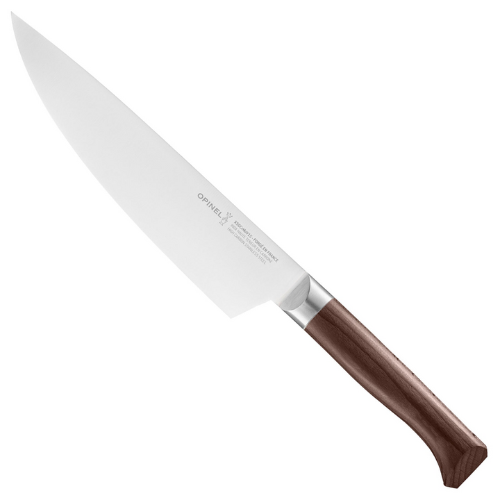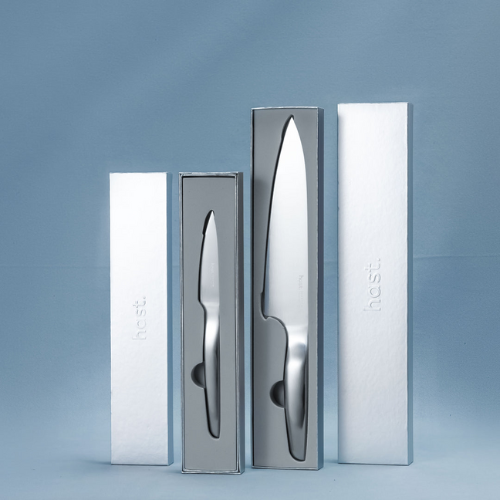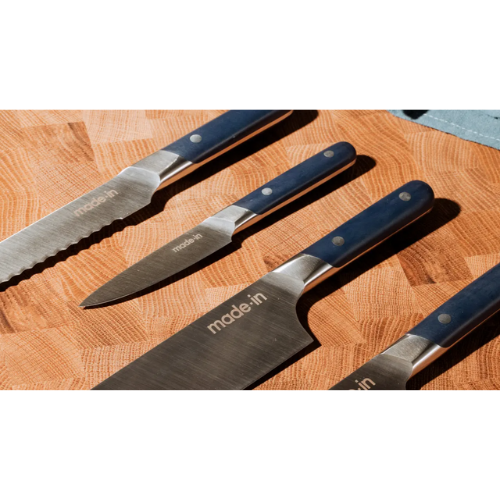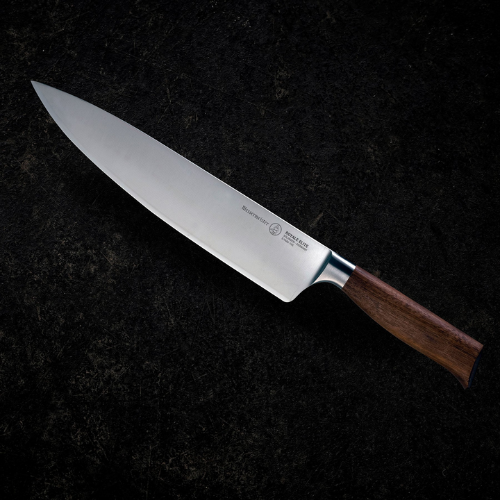The Best Kitchen Knives: Tested and Reviewed
- Oops!Something went wrong.Please try again later.

Our editors independently select the products we recommend. We may earn a commission on items bought through our links.
In his magnum opus, Kitchen Confidential, Anthony Bourdain wrote that all a home cook needs is one good chef’s knife. A boning knife is worth it if you cook a lot of fish, and a bread knife can come in handy, but he scoffed at the idea that you need a set of eight knives to cook good, honest food. His knife of choice is the 8-inch unit from Global Cutlery, which he praised for its utility and design. the Global Cutlery,
Today's Top Deals
He’s right, they’re cool as hell, and at $129 not expensive for being a Japanese blade with professional play. So to echo the methodology of le maitre, and to keep your eyes from glazing over by discussions of the Rockwell hardness scale, we pick up where Bourdain left off. What kind of knives does a serious home cook actually need?
How Do You Test Kitchen Knives?
How did I test these knives? I wish I could tell you that I used them all to butcher a ram, carve flowers into radishes, bone delicate Dover sole, and mince 4,000 cloves of garlic. But that’s not how, well, anyone, actually cooks at home. What I did was put them into heavy rotation in a hungry household of four that cooks all the damn time. I sliced, chopped, minced, and otherwise made food for my family because that’s what I need a hard-wearing, good-looking kitchen knife to do.
I put serrated knives to the test on loaves of crusty bread and thick-skinned tomatoes. I used the paring knives for the finesse jobs, and as for the chef’s knives, as Bourdain instructs, I gripped those whilst cooking everything else.
I was looking for knives that didn’t hurt mincing the sixth clove of garlic, but also passed a certain aesthetic test. I paid close attention to which knives I wanted to use over and over again. The ones that had the right balance of heft and precision, that I could imagine cooking with for the next 10 years and would invest in properly sharpening and cleaning. I also noticed which ones I nearly always passed over. I paid attention to knife construction and provenance, but I didn’t get too bogged down in the finer points of steel production or esoteric Japanese manufacturing techniques. If you need a degree in materials science to understand your knife, you’ve long since stopped cooking. Let the gear heads serve Aogami steel with just the right percentage of tungsten to their kids for supper.

Opinel Les Forgés 1890 8" Bread and Chef Knives
Buy the Chef's knife
Buy the bread knife
Utility
These are the knives I keep reaching for over and over again. I tested out the 8” Chef’s Knife and the Bread Knife from Opinel’s Les Forgés 1890 range and have fallen hard for the Chambery, France-made blades. They’re full tang knives made from fully forged stainless steel in the French Alps and they feel sublime to use.
For those uninitiated, the tang is a single piece of steel that comprises the blade and part of the handle. The handle, whether wood or plastic, clamps onto the central steel spine. Fully tanged knives are broadly thought to be more durable and steady than partially tanged choppers.
I’ve loved every chop, mince, and dice, and I’ve gone back to the Chef’s Knife in particular over and over. I’ve found it substantial, balanced, and sharp. It might be the heaviest of the chef’s knives I’ve tested, and that’s very much what I’m looking for.
The bread knife also performs brilliantly, it’s French after all, and it runs just as well through veggies. The Les Forgés 1890 line celebrates Opinel’s heritage, it was founded in 1890, and I was thrilled to see that the brand famous for its folding pocket knife is just as deft in the kitchen. High marks!
Looks
I happen to really like how the Opinel knives look, though they’re probably the most classic of the lot. If you want something that is clean and modern, then the Opinels might not be the pick for you. But, if you’re looking to add a little Old World chef de cuisine style to your kitchen, then you should absolutely jump at these stainless steel and beechwood blades. Aesthetically, I’ve loved the arced blade of the bread knife and love the full set of Les Forgés 1890 along with their leather knife roll.
Did I feel like a chef?
Mais oui! Tartiflette here I come.

Hast Selection Series 2-Piece Japanese Steel Knife Set
Buy Now
Utility
I’ve played with the Hast chef’s knife and paring knife for the last couple of months, and I have to say that they’ve left me cold. I wish they had more heft, the blade tends to stick in my cutting boards, and I much preferred the wooden handles on two other knives I tested. I like that these knives are made of Japanese carbon steel, and they’re certainly less expensive than the Opinels, but every time I sliced with the Hasts, my mind wandered to the other knives in my block.
Looks
This brand shines in style rather than substance. The Hast line looks cool, and if I had to pick one of these four sets to show off on your magnetic knife bar, it’s Hast. They come in a couple of different colors including black, especially hip, and gold. If you buy the full set of seven Hast knives they come in a transparent container for display.
But ask yourself, how serious a piece of kitchen equipment can this knife be when it’s powder-coated in gold and sells for just over 100 clams? Unfortunately, not a knife that I’m eager to use over and over again.
Did I feel like a chef?
I felt like Apartment Therapy isn’t where anyone should get their knife recs.

Made In Knife Set
Buy Now
Utility
Made In is part of the current crop of internet DTC cookware brands that range from solid (Our Place) to poor (Great Jones). In this case, the knives are adequate. They’re fine looking, they don’t cost too much or too little, they have decent provenance but no real sense of style. There’s a reason they’re the internet’s favorite knives. They’re designed to please almost everyone and offend no one.
I tested out their four-piece set of an 8” chef’s knife, bread knife, paring knife, and 6” Nakiri. (A Nakiri is a Japanese knife specifically designed for chopping vegetables, think of it as the vegetarian cousin to the Santuko.) Like Bourdain, I ended up with little use for the paring knife, but found the chef’s knife and bread knife both able and up to the task. Like the Opinels, they’re full tang, fully forged, and fully French. They had nice heft and balance. Made In’s blades are crafted in Thiers, France by a fifth-generation knifemaker. All told, Made In came in second on the utility scale just behind Opinel.
Looks
To me, the Made In knives are quite middle of the road. The color options on the handles hold some visual appeal, especially in red. The black and navy shades essentially read as “knife handle” in your block, but the beech wood handles give a natural feel. In fact, the most aesthetically appealing configuration of the Made In set is with the brand’s magnetic knife block, made of Italian beech.
I found the Made In branding especially conspicuous on the knife blade, and it detracted from the overall aesthetic experience. This is the only knife in the consideration set branded on both sides of the blade, giving the home chef the feeling that before long the Ralph Lauren pony and Nike swoosh would soon be staring back up at me from my cutting board. None of these points are deal breakers, but I found myself yearning for something more understated.
Did I feel like a chef?
Yes. But decided sub-Bourdainian. Maybe more like a line cook at a high-end grain bowl spot.

Messermeister Royale Elite Stealth 10" Chef's Knife
Buy Now
Utility
For the price, and the provenance, I was surprised that the Royale Elite Stealth wasn’t fully tanged. The wooden handle doesn’t appear to have any steel in it, and it’s thinner than Messermeister’s others which allows for a finer edge but also makes the chopping experience feel imbalanced. The knife is still usable, but as the most expensive of the chef’s knives in our test, it’s hard to recommend it over the fully tanged Opinel or Made In.
Looks
The Messermeister Royale Elite Stealth Chef’s Knife (yeesh, what a mouthful) looks like a big old German blade. And I confess that I have a soft spot for Hof Brau vibes, so I was excited about this charming chopper. Though it wasn’t my favorite in terms of utility, I very much dig its vibe. The wooden handle and extra hard German stainless steel blade make this ideal for Mitteleuropean fare and will have you feeling like you run a schnitzel shop even if you’re just making avocado toast.
Did I feel like a chef?
I did! A big German knife will do that to you. At the end of the day, though, I longed for the feeling of France.
More Top Deals from SPY
Best of SPY
